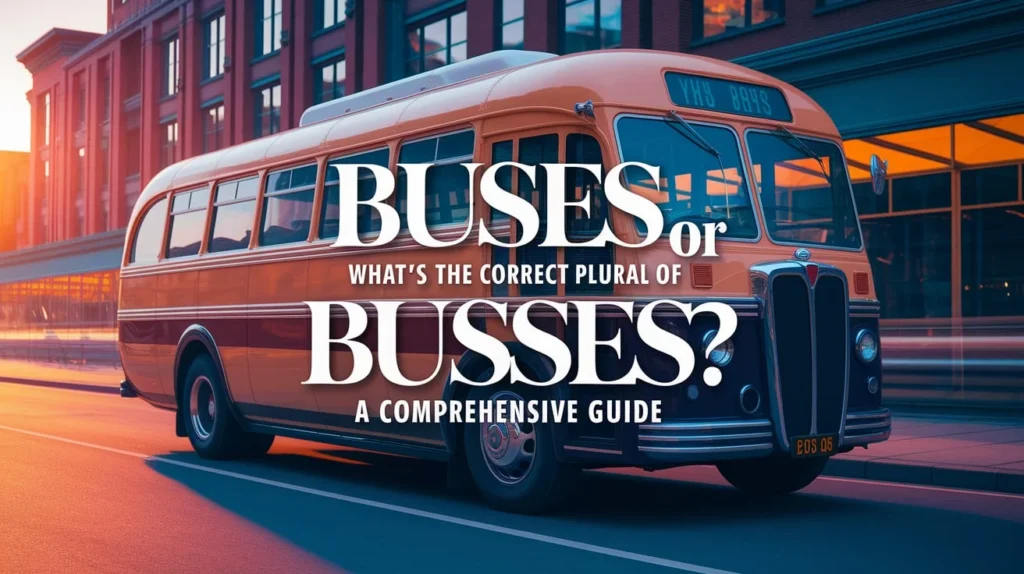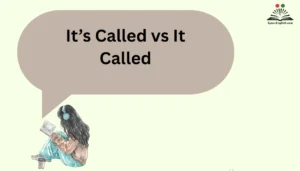Language is full of quirks and oddities, especially when it comes to pluralization rules. One of the most common debates is whether the correct plural form of “bus” is “buses” or “busses.” While this may seem like a trivial issue at first glance, it actually causes a surprising amount of confusion. So, if you’ve ever found yourself wondering, “Should I say ‘buses’ or ‘busses’?”, you’re not alone.
Understanding the correct form isn’t just important for casual conversation—it matters in writing too. After all, using the wrong plural could undermine your credibility or give your writing a careless feel. That’s why we’ve created this comprehensive guide to clear up any confusion. We’ll dive into the reasons why this pluralization puzzle exists, why “buses” is the correct choice, and explore related terms to help you avoid similar pitfalls in the future. Along the way, we’ll also touch on the historical background of the word and why understanding English’s often confusing rules can elevate your writing.
By the end of this post, you’ll know not only the correct plural form of “bus” but also how to approach other words with similar rules, ensuring your writing is grammatically sound and professional.
Why Is There Confusion Over “Buses” vs. “Busses”?
If you’ve ever hesitated between writing “buses” and “busses,” you’re certainly not alone. The confusion comes from English’s rather unpredictable pluralization rules, which can be tricky even for native speakers. So why does “busses” seem to appear occasionally, despite the consensus that “buses” is the correct form?
The Pluralization Rule in English
In general, English tends to add “-s” or “-es” to the end of most words to form the plural. However, the rules for adding “-es” vary depending on the last letters of the singular form. For example, nouns ending in -s, -x, -z, -sh, or -ch typically require the addition of -es to form the plural (e.g., box → boxes, glass → glasses, bus → buses). This is where things get interesting: although “bus” ends with “-s,” which should traditionally take an “-es” plural, “busses” also appears in certain contexts.
This leads us to the main source of confusion: in the past, many people used “busses” as the plural form, likely due to influence from other words like kiss and miss, which use “-es” for pluralization. Over time, however, “buses” became the standard plural, solidifying itself in dictionaries and style guides as the most widely accepted form.
“Buses” vs. “Busses”: The Correct Plural of “Bus”
Why “Buses” Is the Correct Plural Form
The plural form of “bus” is buses. This follows the general rule for nouns ending in -s, -x, -z, -sh, or -ch. These nouns take -es to form the plural, and “bus” is no exception. So, when you’re referring to multiple buses, the correct pluralization is “buses,” not “busses.”
Here’s a breakdown:
- Bus → Buses
- Glass → Glasses
- Box → Boxes
- Brush → Brushes
Grammar Experts’ Consensus
Modern grammar and style guides, including the Merriam-Webster Dictionary and the Oxford English Dictionary, all support “buses” as the correct plural form. The use of “busses” has largely fallen out of favor due to the consistent application of the -es rule. In fact, many respected grammar experts emphasize that “busses” is an outdated form, and while it may be found in older texts, it’s best to stick with “buses” for clarity and correctness.
In short: “Buses” is the grammatically sound, widely accepted plural form.
What Is a “Bus”?
Before we dive deeper into pluralization, let’s quickly define what a “bus” is. While most of us are familiar with buses in the context of public transportation, the word itself has broader uses.
Definition of a Bus
A bus is generally any large, motorized vehicle designed to carry many passengers. Buses are typically used for mass transit in cities, schoolchildren transport, or even long-distance travel in the form of coach buses.
Here are some types of buses:
- Public Transit Bus: These are used to transport passengers within a city or town.
- School Bus: A vehicle used to transport children to and from school.
- Tour Bus or Coach Bus: Used for long-distance travel, often for leisure or tourism purposes.
- Minibus: A smaller bus, often used for group transport in more specific settings.
In everyday language, “bus” refers to any of these vehicles depending on the context. Its flexibility in meaning is part of the reason the term is so widely used.
Words with Similar Pluralization Rules
English is full of words that follow the same pluralization rules as “bus.” To understand why “buses” is correct, it helps to look at other words that end in -s, -x, -z, -sh, or -ch. These words all require an -es ending to form the plural.
Examples of Words Following the Same Rule:
- Glass → Glasses
- Box → Boxes
- Class → Classes
- Church → Churches
- Match → Matches
- Boss → Bosses
As you can see, words that end in “-s” but are not related to “bus” also follow the same pluralization rule. Therefore, it’s no surprise that the plural of “bus” follows the same pattern.
Exceptions to the Rule: However, English is notorious for its exceptions. Take a look at words like axis → axes or crisis → crises, which don’t follow the typical “-es” rule despite ending in “-s.” These exceptions often have historical or linguistic reasons, but for the most part, the -es pluralization pattern holds strong.
Alternative Terms for “Bus”
While “bus” is a common word, there are many other terms and phrases used to describe similar types of vehicles. These terms may be used depending on context, formality, or the type of bus being referenced.
Here are some alternatives for “bus”:
- Coach: Often used for longer trips, such as a coach bus or charter bus.
- Shuttle: A smaller, often repetitive transportation vehicle used for short distances (e.g., airport shuttle).
- Minibus: A smaller version of a bus, designed to hold fewer passengers, often used for specific group travel.
- Transit: A more generic term for public transportation, which can refer to buses, trains, or other forms of mass transit.
Each of these terms may be used depending on the context in which you’re referring to public or private transportation, but all generally fall under the broader category of “bus.”
Sentences Using “Buses”
To help clarify how “buses” is used in context, here are some example sentences:
- “The city’s buses run every 15 minutes during peak hours.”
- “I saw three buses waiting at the station when I arrived.”
- “Buses are a popular form of transportation for commuters in urban areas.”
- “In some cities, buses are more reliable than other forms of transit.”
By using “buses” in these examples, you can see how it’s applied to describe multiple vehicles, and how the pluralization rule fits perfectly in these sentences.
Etymology of “Bus”
The word “bus” itself has an interesting history that dates back centuries. It’s actually a shortening of the word “omnibus”, which comes from the Latin word meaning “for all.” In the early 19th century, “omnibus” was used to describe a type of public transportation vehicle that carried multiple passengers. Over time, this term was shortened to “bus,” and the plural form evolved in line with English’s regular pluralization rules.
The Evolution of “Bus”
- Omnibus (Latin: for all) → Bus (shortened term)
- Early usage of “bus” referred to horse-drawn carriages for public transportation.
- With the advent of motorized vehicles, the term “bus” began to refer to larger, more modern forms of public transit.
Interestingly, “omnibus” was coined in the early 1800s in Paris, and the term spread rapidly across Europe and the United States. The plural form “buses” stuck because of the pattern used for words ending in “-s.”
Conclusion
In conclusion, the correct plural of “bus” is buses, not busses. This follows the standard rule for pluralizing words that end in -s, -x, -z, -sh, or -ch. While “busses” was once an accepted form, “buses” has become the preferred plural in modern usage, as confirmed by leading grammar guides and linguistic authorities.
By understanding the rules of pluralization and paying attention to the words around you, you can ensure that your writing stays grammatically correct and clear. The next time you’re referring to multiple buses, you’ll know exactly which form to use. And remember, English can be tricky, but with a little practice, you’ll get the hang of it!

Emma Brooke is a passionate English educator, writer, and language enthusiast with over a decade of experience helping learners master the nuances of the English language. At SynoEnglish, she blends practical grammar advice with real-world communication tips to make English easier, clearer, and more enjoyable for readers of all levels.



